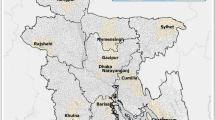Abstract
This study investigated the relationship between the CO2 concentration and land surface temperature in Bengaluru, a recently mega industrialized city located in Southern India. Geographically weighted regression (GWR) was performed to explore the inter-relationship between orbiting carbon observatory-2 (OCO-2) XCO2 and moderate resolution imaging spectroradiometer MODIS-LST (land surface temperature). The GWR coefficient (R2 Adjusted), 0.91, confirms the strong correlation between OCO-2 XCO2 and MODIS LST over the study area. This study confirmed the industrial belt is one of the strong reasons for the remarkable increase in carbon concentration since the study area is surrounded by aerospace manufacturing industries and information technology building. The results of this study can be utilized as an important reference for evaluating the correlation between industrial belt and carbon emissions in south-east Asian countries where industrial belt is intensively constructed.









Similar content being viewed by others
References
Sarif, M., Rimal, B., & Stork, N. E. (2020). Assessment of changes in land use/land cover and land surface temperatures and their impact on surface urban heat island phenomena in the Kathmandu Valley (1988–2018). ISPRS International Journal of Geo-Information, 9(12), 726.
Pathak, C., Chandra, S., Maurya, G., Rathore, A., Sarif, M. O., & Gupta, R. D. (2021). The effects of land indices on thermal state in surface urban heat island formation: A case study on Agra City in India using remote sensing data (1992–2019). Earth Systems and Environment, 5(1), 135–154.
Zhan, W., Chen, Y., Zhou, J., Wang, J., Liu, W., Voogt, J., et al. (2013). Disaggregation of remotely sensed land surface temperature: Literature survey, taxonomy, issues, and caveats. Remote Sensing of Environment, 131, 119–139.
Li, Z.-L., Tang, B.-H., Wu, H., Ren, H., Yan, G., Wan, Z., et al. (2013). Satellite-derived land surface temperature: Current status and perspectives. Remote Sensing of Environment, 131, 14–37.
Wan, Z. (2014). New refinements and validation of the collection-6 MODIS land-surface temperature/emissivity product. Remote Sensing of Environment, 140, 36–45.
Lu, S., Wang, J., Wang, Y., & Yan, J. (2018). Analysis on the variations of atmospheric CO2 concentrations along the urban–rural gradients of Chinese cities based on the OCO-2 XCO2 data. International journal of remote sensing, 39(12), 4194–4213.
Wunch, D., Wennberg, P. O., Osterman, G., Fisher, B., Naylor, B., Roehl, C. M., et al. (2017). Comparisons of the orbiting carbon observatory-2 (OCO-2) X CO 2 measurements with TCCON. Atmospheric Measurement Techniques, 10(6), 2209–2238.
Wunch, D., Wennberg, P. O., Osterman, G., Fisher, B., Naylor, B., Roehl, C. M., et al. (2016). Comparisons of the Orbiting Carbon Observatory-2 (OCO-2) XCO2 measurements with TCCON [Discussion paper].
Chejarla, V. R., Maheshuni, P. K., & Mandla, V. R. (2016). Quantification of LST and CO2 levels using Landsat-8 thermal bands on urban environment. Geocarto International, 31(8), 913–926.
Davis, W. J. (2017). The relationship between atmospheric carbon dioxide concentration and global temperature for the last 425 million years. Climate, 5(4), 76.
Martínez-Zarzoso, I., & Maruotti, A. (2011). The impact of urbanization on CO2 emissions: Evidence from develo** countries. Ecological Economics, 70(7), 1344–1353.
Scheffer, M., Brovkin, V., & Cox, P.M. (2006). Positive feedback between global warming and atmospheric CO2 concentration inferred from past climate change. Geophysical Research Letters 33:10.
Govind, N. R., & Ramesh, H. (2019). The impact of spatiotemporal patterns of land use land cover and land surface temperature on an urban cool island: a case study of Bengaluru. Environmental monitoring and assessment, 191(5), 1–20.
Li, H., Calder, C. A., & Cressie, N. (2007). Beyond Moran’s I: testing for spatial dependence based on the spatial autoregressive model. Geographical Analysis, 39(4), 357–375.
Hu, Q., Ma, Y., Xu, B., Song, Q., Tang, H., & Wu, W. (2018). Estimating sub-pixel soybean fraction from time-series MODIS data using an optimized geographically weighted regression model. Remote Sensing, 10(4), 491.
Dissanayake, D., Morimoto, T., Murayama, Y., Ranagalage, M., & Handayani, H. H. (2019). Impact of urban surface characteristics and socio-economic variables on the spatial variation of land surface temperature in Lagos City. Nigeria. Sustainability, 11(1), 25.
Bokaie, M., Zarkesh, M. K., Arasteh, P. D., & Hosseini, A. (2016). Assessment of urban heat island based on the relationship between land surface temperature and land use/land cover in Tehran. Sustainable Cities and Society, 23, 94–104.
Acknowledgements
This research was supported by Basic Science Research Program through the National Research Foundation of Korea (NRF) funded by the Ministry of Education (NRF–2018R1D1A1B07041977). We thank National Aeronautics and Space Administration, United States (NASA) for providing OCO-2 and MODIS LST satellite data. The Google Earth image used in this paper was obtained using the free download function provided by Google Earth. We thank Google Earth for providing the satellite images and permission to use them for this study.
Author information
Authors and Affiliations
Corresponding author
Ethics declarations
Conflict of interest
In this research article, the authors have no conflict of interest.
Additional information
Publisher's Note
Springer Nature remains neutral with regard to jurisdictional claims in published maps and institutional affiliations.
Rights and permissions
About this article
Cite this article
Matloob, A., Sarif, M.O. & Um, JS. Evaluating the inter-relationship between OCO-2 XCO2 and MODIS-LST in an Industrial Belt located at Western Bengaluru City of India. Spat. Inf. Res. 29, 257–265 (2021). https://doi.org/10.1007/s41324-021-00396-4
Received:
Revised:
Accepted:
Published:
Issue Date:
DOI: https://doi.org/10.1007/s41324-021-00396-4




